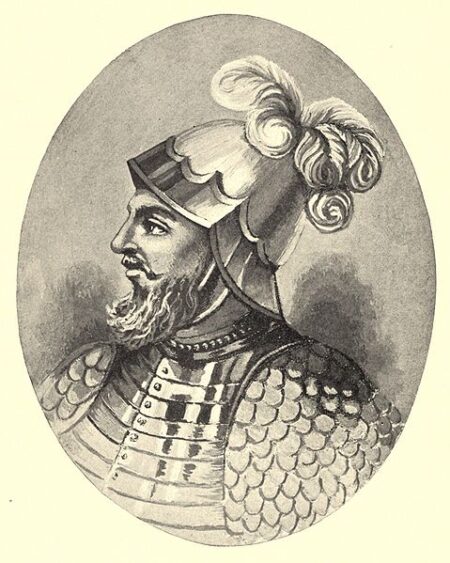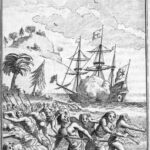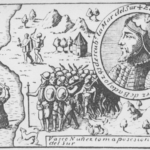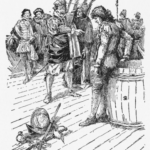Vasco Nuñez de Balboa
Explorer
Age of Discovery
Quick Facts:
Explorer and Conquistador who was head of the first South American settlement, and the first European to discover the Pacific Ocean
Introduction
Vasco Nuñez de Balboa was a Spanish explorer, governor, and conquistador. He is best known for leading an expedition across the narrow isthmus of Panama, and reaching the Pacific Ocean, becoming the first European to see this large body of water. Like many explorers of his day, Balboa went to the new world seeking riches and adventure. He achieved both, but it was not enough to save him from an unfortunate ending.
Biography
Early Life
Vasco Nuñez de Balboa was born around the year 1475 in Jerez de los Caballeros, a town in the Extremadura region of Spain. His father was Don Nuño Arias de Balboa, but not much is known about his mother. His family was noble, but by the late fifteenth century it had lost most of its money, land, and influence. Like most children of nobility at this time, young Balboa received training as a knight and, later, a soldier. He was sent to Moguer, Spain where he served as a page to the Lord of Moguer.1 Here, he learned skills that would help him on his future journeys such as hunting and training to fight.
Moguer was a major seaport town. Balboa heard stories from sailors on the docks of the riches and adventures that awaited in the New World. Spain during this period was sending many expeditions to the New World in search of land, riches, and opportunities to colonize the natives. In 1500, Balboa joined Don Rodrigo de Bastidas on a journey to explore the northern coast of modern day South America. Balboa was one of several men sent to defend the expedition from hostile natives. Balboa finally got his chance for adventure.
Voyages
Principal Voyage
Balboa and his men set sail in 1501 with two ships, the Santa Maria de Gracio and the San Anton.2 They crossed the Atlantic Ocean, and eventually reached the northern coast of South America, near present day Venezuela and Colombia. They sailed along an area called the Coast of Pearls for four months, stopping to interact and trade with the natives along the way. By October, they reached the Gulf of Urabá, a bay near present day Colombia. They continued sailing west towards Panama where once more they traded with natives. They soon noticed that their ship had serious damage. They were able to sail to Santo Domingo, Hispaniola before it was too late. Here, governor Nicolas de Ovando had Bastidas and his men, including Balboa, imprisoned for trading with the natives.3 Ovando soon released them, and Bastidas returned to Spain. Balboa, however, was not ready to leave the New World. He remained there for another eight years before he got another chance for adventure. He settled on the island of Hispaniola where he made his living as a farmer, but he was not successful and soon found himself in great debt. But this did not stop Balboa for his next chance at a new adventure.
Vasco Nuñez de Balboa learned that a man, Martin de Enciso, was going to the Pearl Coast. Their task was to bring supplies to the colony of San Sebastian located on the coast of Uraba (now Colombia) lead by Alonso de Ojeda. Balboa was heavily in debt, and his debtors would not let him join Enciso’s party. To avoid this, in 1510, Balboa escaped his creditors by stowing away on Enciso’s ship – an act punishable by death. Still, Balboa revealed himself to the captain. Instead of having Balboa thrown overboard, Enciso let Balboa join the crew since he had been to the area which they were heading. When they arrived, they found Ojeda had left the settlement, most of the settlers were dead, and soon to be famous conquistador Francisco Pizarro was in charge. Enciso, Balboa, and the San Sebastian survivors abandoned the settlement and set up a new colony at Darien, in modern day Panama. At Darien, the remaining colonists revolted against Enciso’s leadership. Balboa was chosen as the new leader and governor.4
Subsequent Voyages
Balboa, like other explorers, heard tales of great places that had to be discovered. For Balboa, he learned of a great ocean beyond the South American Mountains. Balboa had been falsely accused of treason by his enemies in Spain, and lost favor with the king. His request to search for this ocean was denied by the king of Spain. He was also replaced as governor of Darien by a man named Pedro Arias Dávila (usually called Pedrarias). Still, in September 1513, he took 100 Spaniards – including Francisco Pizarro – and 1000 natives and searched for the sea himself.5 The expedition headed south and fought its way through the jungle. After 24 days and 45 miles, Balboa saw what he was looking for. On either September 25 or 27, 1513 (sources differ on the day) Vasco Nuñez de Balboa became the first European to discover a new ocean.6 He named it the South Sea; today it is called the Pacific Ocean. On September 29, Balboa went into the water and claimed the sea, its islands and lands for Spain. He remained here for some time, and then began working his way back to Darien, arriving in January 1514.7
Balboa wrote letters to the king of his South Sea discovery. He was now back in good favor with the king of Spain. He rewarded Balboa by appointing him governor of the provinces of Panama and Coiba.8 But he would still be under the authority of Pedrarias, who arrived in Darien in mid-1514. Though suspicious of each other, the two men tried to maintain peace. Pedrarias gave Balboa permission to further explore the South Sea. Balboa and his men built two ships and transported them in pieces across the mountains to the Pacific shore. Balboa set sail and from 1517 and part of 1518 he explored the part of the South Sea called the Gulf of San Miguel.9 Pedrarias summoned Balboa back to Darien, and life for Balboa became much more difficult.
Later Years and Death
Before Balboa left to explore the South Sea, relations between him and Pedrarias were strained, but well. Pedrarias even betrothed his daughter Maria (in Spain) to Balboa, meaning they were to be married. But good relations between the two men did not last. There was distrust, and Pedrarias was jealous of Balboa’s successes. When Balboa was summoned back to Darien, Pedrarias had him arrested and imprisoned on false charges of starting a rebellion.10 He was quickly tried for treason against the crown. Although Balboa denied the charge he was found guilty. He was sentenced to death, and beheaded on January 21, 1519.11
Legacy
Vasco Nuñez de Balboa helped establish the first stable European settlement on the mainland of South America. The colony of Darien in Panama helped Spain establish a vast colonial empire in the Americas. Balboa is also credited as being the first European to see the Pacific Ocean from the New World. Balboa’s expedition to the Pacific changed the world for Spain. Spain now knew that there was indeed ocean to sail to the east. However, it would be Ferdinand Magellan who would get the credit for naming it the Pacific Ocean when he rounded the southern tip of South America in 1520. Today, Balboa’s legacy is seen throughout Panama by the streets and parks that bear his name, and a monument in his honor in Panama City. The currency of this country is even called Balboa, after the great explorer who helped put this land on the map.12
EndnotesImages





